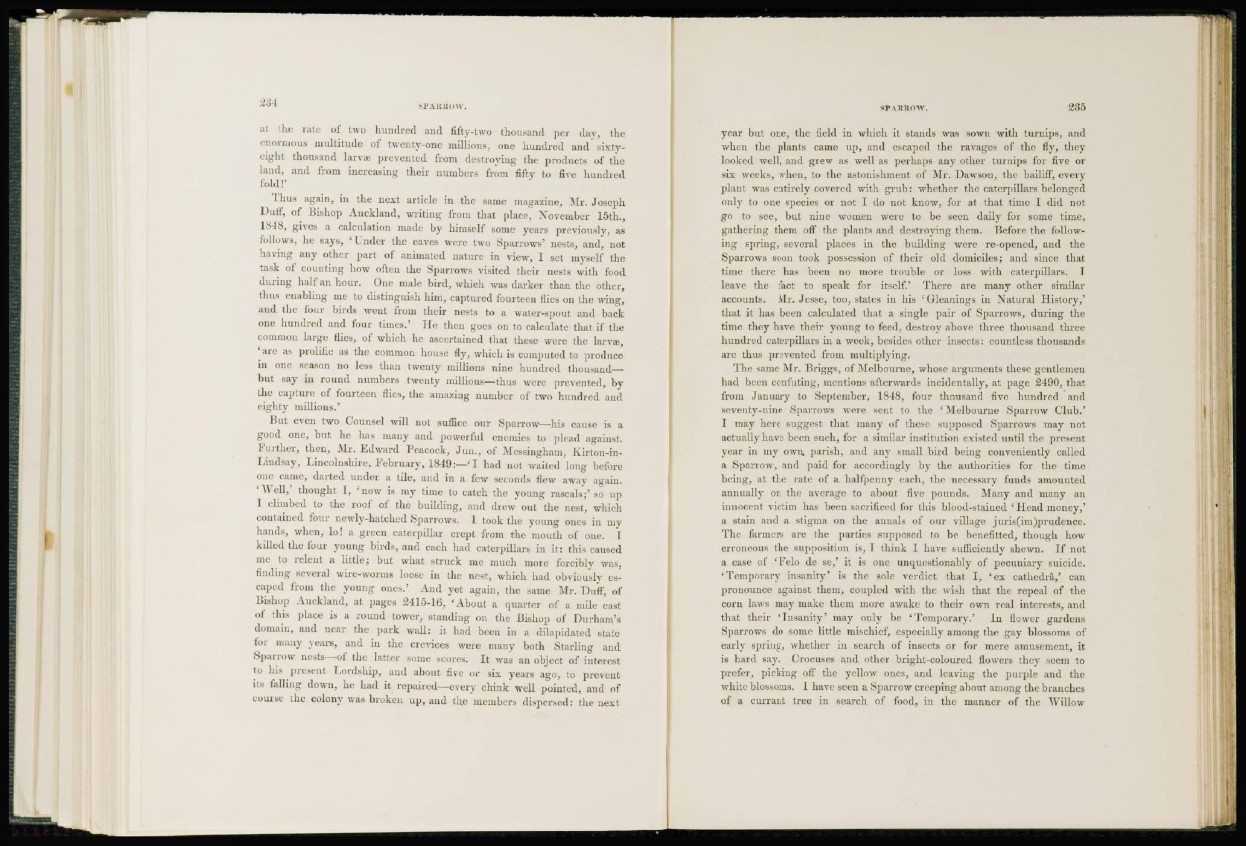
at the rate of two hundred and fifty-two thousand per day, the
enormous multitude of twenty-one millions, one hundred and sixtyeight
thousand larva? prevented from destroying the products of the
hind, and from increasing their numbers from fifty to five hundred
fold!'
Thus again, in the next article in the same magazine, Mr. Joseph
Duif, of Bishop Auckland, writing from that place, November 15th.,
I M S , gives a calculation made by himself some years previously, as
follows, he says, 'Under the eaves were two Sparrows' nests, and, not
having any other part of animated nature in view, 1 set myself the
task of counting how often the Sparrows visited their nests with food
during half an hour. One male bird, which was darker than the other,
thus enabling me to distinguish him, captured fourteen flies on the wing,
and the four birds went from their nests to a water-spout and back
one hundred and four times.' He then goes on to calculate that if the
common large flies, of which he ascertained that these were the larva?,
'arc as prolific as the common house fly, which is computed to produce
in one season no less than twenty millions nine hundred thousand—
but say in round numbers twenty millions—thus were prevented, by
the capture of fourteen Hies, the amazing number of two hundred and
eighty millions.'
But even two Counsel will not suffice our Sparrow—his cause is a
good one, but he has many and powerful enemies to plead against.
Further, then, Mr. Edward Peacock, Jun., of Messingham, Kirton-in-
Lindsay, Lincolnshire. February, 1849:—'I had not waited long before
one came, darted under a tile, and in a few seconds flew away again.
'"Well,' thought I, 'now is my time to catch the young rascals;' so up
1 climbed to the roof of the building, and drew out the nest, which
contained four newly-hatched Sparrows. I took the young ones in my
hands, when, lo! a green caterpillar crept from the mouth of one. I
killed the four young birds, and each had caterpillars in it: this caused
me to relent a little; but wdiat struck me much more forcibly was,
finding several wire-worms loose in the nest, which had obviously escaped
from the young ones.' And yet again, the same Mr. Duff, of
Bishop Auckland, at pages 2415-16, "About a quarter of a mile east
of this place is a round tower, standing on the Bishop of Durham's
domain, and near the park wall: it had been in a dilapidated state
for many years, and in the crevices were many both Starling and
Sparrow nests—of the latter some scores. It was an object of interest
to his present Lordship, and about five or six years ago, to prevent
its falling down, he had it repaired—every chink well pointed, and of
course the colony was broken up, and the members dispersed: the next
year but one, the field in which it stands was sown with turnips, and
when the plants came up, and escaped the ravages of the fly, they
looked well, and grew as well as perhaps any other turnips for five or
six weeks, when, to the astonishment of Mr. Dawson, the bailiff, every
plant was entirely covered with grub: whether the caterpillars belonged
only to one species or not I do not know, for at that time I did not
go to see, but nine women were to be seen daily for some time,
gathering them off the plants and destroying them. Before the following
spring, several places in the building were reopened, and the
Sparrows soon took possession of their old domiciles; and since that
time there has been no more trouble or loss with caterpillars. I
leave the fact to speak for itself.' There are many other similar
accounts. Mr. Jesse, too, states in his ' Gleanings in Natural History,'
that it has been calculated that a single pair of Sparrows, during the
time they have their young to feed, destroy above three thousand three
hundred caterpillars in a week, besides other insects: countless thousands
are thus prevented from multiplying.
The same Mr. Briggs, of Melbourne, whose arguments these gentlemen
had been confuting, mentions afterwards incidentally, at page 2490, that
from January to September, 1848, four thousand five hundred and
seventy-nine Sparrows were sent to the 'Melbourne Sparrow Club.'
I may here suggest that many of these supposed Sparrows may not
actually have been such, for a similar institution existed until the present
year in my own, parish, and any small bird being conveniently called
a Sparrow, and paid for accordingly by the authorities for the time
being, at the rate of a halfpenny each, the necessary funds amounted
annually on the average to about five pounds. Many and many an
innocent victim has been sacrificed for this blood-stained ' Head money,'
a stain and a stigma on the annals of our village juris(im)prudcnce.
The farmers are the parties supposed to be benefitted, though how
erroneous the supposition is, I think I have sufficiently shewn. If not
a case of ' Felo de se,' it is one unquestionably of pecuniary suicide.
' Temporary insanity' is the sole verdict that I, ' ex cathedra,' can
pronounce against them, coupled with the wish that the repeal of the
corn laws may make them more awake to their own real interests, and
that their 'Insanity' may only be 'Temporary.' In flower gardens
Sparrows do some little mischief, especially among the gay blossoms of
early spring, whether in search of insects or for mere amusement, it
is hard say. Crocuses and other bright-coloured flowers they seem to
prefer, picking off the yellow ones, and leaving the purple and the
white blossoms. I have seen a Sparrow creeping about among the branches
of a currant tree in search of food, in the manner of the Willow